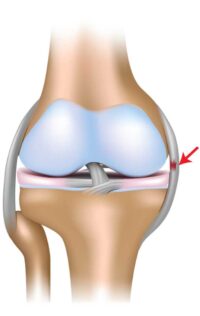Medial Collateral Ligament (MCL) Knee Injury Specialist

Are you an athlete who participates in contact sports, or jumping and landing? If so, you may be at risk of tearing your MCL. An MCL injury can be sustained during an awkward landing in athletic activities, dirt biking injury or from a tackle in football. MCL tear specialist, Dr. Jeff Padalecki provides diagnosis and both surgical and nonsurgical treatment options for patients in Austin who have developed an MCL tear. Contact Dr. Padalecki’s team today!
What is a Medial Collateral Ligament Injury (MCL Injury)?
The MCL, or medial collateral ligament, is located on the inside of the knee and extends from the end of the thighbone (femur) to the top of the shin bone (tibia). The MCL provides “side to side” stability and protects against widening of the inside of the knee. An MCL injury occurs when the outside of the knee is struck, causing the knee to “cave in” – such as with a tackle in football or an awkward landing in an activity such as skiing. Austin, Round Rock, and Cedar Park, Texas residents that have experienced an MCL injury are encouraged to contact Dr. Jeff Padalecki for an orthopedic appointment. Dr. Padalecki is a knee specialist trained and highly experienced at treating knee injuries, including a torn MCL.

How are MCL Injuries Classified?
An injury to the MCL of the knee can be a stretch, a partial tear, or a complete tear of the ligament. There are 3 grades of an MCL injury:
- Grade I: Incomplete tear; the ligament is still intact but stretched, with mild pain.
- Grade II: A partial or incomplete tear; significant pain and instability when attempting to cut or pivot.
- Grade III: A complete tears of the MCL; significant pain along the medial aspect of the knee. Typically this tear occurs in combination with other injuries in the knee.
What are the Symptoms of an MCL Injury?
The most common symptom in an MCL injury is pain. Swelling may appear as well as some bruising over the joint. In more severe cases, the knee may feel unstable or as if it will give out when weight bearing.
How is an MCL Injury Diagnosed?
Dr. Padalecki will conduct a thorough examination of the knee and conduct a series of tests to check overall mobility, severity of pain and strength. A variety of tests may be utilized to determine the extent of the injury which may include stress X-rays or MRI.
How is an MCL Injury Treated?
Non-Surgical
The majority of MCL injuries are not treated non-surgically. Most of them heal with a combination of rest and a physical rehabilitation program to help strengthen the knee and increase flexibility. In some instances a brace is necessary to provide extra protection and support to the knee as it heals. If the MCL is simply stretched or partially torn, then conservative treatment usually corrects the MCL in 6-8 weeks.
Surgical
Surgical treatment of MCL injuries is often recommended for tears or in cases where there is an associated meniscus or ligament injury. Dr. Padalecki will use a reconstruction technique to reinforce the damaged MCL. This will involve stitching the ligament back together or down to bone, along with the repair of the other injured structures in the knee. He may opt to use a graft (either from the patient or from a cadaver) if the ligament has suffered damage that is beyond repair.
What Occurs after MCL Surgery?
A rehabilitation program will be prescribed at your first post-operative visit with Dr. Padalecki and is critical in resuming normal activities. Therapy will focus on returning motion back to the injured knee and surrounding muscles to help prevent any scar tissue build up after surgery. After that is achieved, you will follow a progressive strengthening program to protect the repaired ligament.
For more information on an MCL injury, such as a torn meniscus, or other sports related injury of the knee, contact the office of Dr. Jeff Padalecki, knee specialist in Austin, Texas.